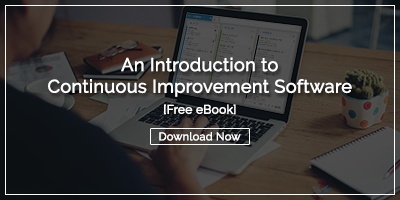 Organizations that adopt the Lean approach to business management have many improvement tools at their disposal. Lean software supports them all in various ways and creates a unified platform for all types of improvement work.
Organizations that adopt the Lean approach to business management have many improvement tools at their disposal. Lean software supports them all in various ways and creates a unified platform for all types of improvement work.
Hoshin Kanri
Hoshin Kanri is a strategy development approach that involves identifying a few breakthrough objectives that can be achieved in 3-5 years. Lean software supports Hoshin planning by aligning each person’s objectives with the overall strategy in the tool that they use for daily improvement work. This keeps the strategy at the top of people's minds.
Catchball
The point of Catchball is to toss ideas back and forth to get input and consensus. Email is a dangerous place for Catchball because it is so easy for messages to be missed and context to be lost. Lean software, on the other hand, is an ideal tool for this kind of back and forth collaboration.
Gemba Walks
The purpose of a Gemba walk is to visit the place where work actually happens and identify opportunities for improvement. The improvements are never made during the walk, only after it is complete and the proper analysis occurs. Lean software becomes the home for each improvement that is identified. It guides the process for those opportunities that have been selected for implementation.
DMAIC and PDSA
DMAIC (Define, Measure, Analyze, Improve, Control) and PDSA (Plan, Do, Study, Act) are variations of the cycle for continuous improvement. Each is designed to ensure orderly and effective change. Lean software is used to document each step of the cycle, notify team members when action is required, and measure the impact of the improvement.
Kanban
Kanban is an approach used by improvement teams to help visualize their workflow and find any interruptions in flow before a backlog forms or grows too big. In Lean software, digital Kanban boards help make it obvious where work is getting delayed. With this easy insight, managers are better able to take the proper steps to solve any problems.
Daily Huddles
Daily huddles are a fairly ubiquitous practice in Lean organizations. Teams gather around a huddle board to discuss improvements and help solve problems. Lean software digitizes the huddle board, making it possible for people to participate from anywhere, capturing the history of improvement, and helping executives stay connected to the improvement work of all the teams they oversee.
Standard Work
Lean software is used to support Standard Work in a number of ways. The process of developing the standard is tracked as an improvement, ensuring that all of the stakeholders are involved. Next, it serves as a repository for the current standard. When the standard needs revision, the cycle begins again.
Lean software doesn’t make improvement. It makes improvement faster, easier, and more impactful. These are just some of the Lean techniques that it supports. We’re sure there are others. We’d love to hear which Lean practices you manage with technology - leave a comment below!



Add a Comment